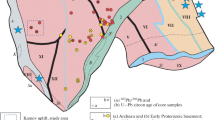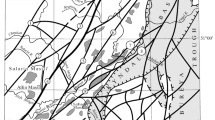Abstract
The Spessart Crystalline Complex, north-west Bavaria contains two orthogneiss units of granitic to granodioritic composition, known as the Rotgneiss and Haibach gneiss, respectively, which are structurally conformable with associated metasediments. The igneous origin of the Rotgneiss is apparent from field and textural evidence, whereas strong deformation and recrystallization in the Haibach gneiss has obscured most primary textures. New geochemical data as well as zircon morphology prove the Haibach gneiss to be derived from a granitoid precursor, which was chemically similar to the Rotgneiss protolith, thus suggesting a genetic link between those two rock units. Both gneiss types have chemical compositions typical of anatectic two-mica leucogranites. They show characteristics of both I- and S-type granites. Rb-Sr whole rock data on the Haibach gneiss provide an isochron age of 407±14 Ma (IR = 0.7077±0.0007; MSWD 2.2), which is slightly younger than the published date for the Rotgneiss (439±15 Ma; IR=0.7048±0.0026; MSWD 4.9). Single zircon dating of six idiomorphic grains, using the evaporation method, yielded a mean 207Pb/206Pb age of 410±18 Ma for the Haibach gneiss and 418±18 Ma for the Rotgneiss. Both zircon ages are within analytical error of the Rb-Sr isochron dates and are interpreted to reflect the time of protolith emplacement in Silurian times. Three xenocrystic zircon grains from the Rotgneiss yielded 207Pb/206Pb ages of 2278±12, 2490±13 and 2734±10 Ma, respectively, suggesting that late Archaean to early Proterozoic crust was involved in the generation of the granite from which the Rotgneiss is derived. Although it is assumed that the granitic protoliths of the two gneisses were formed through anatexis of older continental crust, the relatively low 87Sr/86Sr initial ratios of both gneisses may also indicate the admixture of a mantle component. The Rotgneiss and the Haibach gneiss thus document granitic magmatism at an active continental margin during late Silurian times.
Similar content being viewed by others
References
Batchelor RA, Bowden P (1985) Petrogenetic interpretation of granitoid rock series using multicationic parameters. Chem Geol 48:43–55
Bederke E (1957) Alter und Metamorphose des kristallinen Grundgebirges im Spessart. Abhandl hess Landesamt Bodenforsch 18:7–19
Braitsch O (1957) Zur Petrographic und Tektonik des Biotitgneises im südlichen Vorspessart. Abhandl hess Landesamt Bodenforsch 18:73–99
Brooks C, Hart SR, Wendt I (1972) Realistic use of two-error regression treatments as applied to rubidium-strontium data. Rev Geophys Space Phys 10:551–577
Chappell BW, White AJR (1974) Two contrasting granite types. Pacific Geol 8:173–174
Clarke DB (1992) Granitoid Rocks. Chapman and Hall, London
Dallmeyer RD, Franke W, Weber K (eds). Tectonostratigraphic evolution of the Central European Orogens. IGCP Project 233, Tectonic Series. Springer, Berlin, Heidelberg, New York, in press
de la Roche H, Leterrier J, Grand Claude P, Marchal M (1980) A classification of volcanic and plutonic rocks using R1–R2 diagrams and major element analyses — its relationships with current nomenclature. Chem Geol 29:183–210
Dombrowski A (1992) Der Haibacher Biotitgneis im südöstlichen kristallinen Vorspessart. Unpubl Diploma Thesis, Würzburg, 114 pp
Franke W (1989a) Tectonostratigraphic units in the Variscan belt of central Europe. Geol Soc Am Spec Pap 230:693–708
Franke W (1989b) Variscan plate tectonics in Central Europe — current ideas and open questions. Tectonophysics 169:221–228
Franke W (1990) Rhenohercynian Basin and Mid-German Crystalline Rise — an introduction. In: Franke W (ed) Mid-German Crystalline Rise & Rheinisches Schiefergebirge. Field Guide to Pre-conference excursion. IGCP 233. Terranes in the Circum-Atlantic Paleozoic Orogens. Conference on Paleozoic Orogens in Central Europe — Geology and Geophysics. Göttingen, Giessen, pp 1–15
Franke W, Oncken O (1990) Geodynamic evolution of the North-Central Variscides — a comic strip. In: Freeman R, Giese P, Mueller St (eds) The European Geotraverse: Integrative Studies. Results from the Fifth Study Centre, Rauischholzhausen (26 March – 7 April 1990). European Science Foundation, Strasbourg, pp 187–194
Harland WB, Cox AV, Lwellyn PG, Pickton CAG, Smith AG, Walters R (1982) Geological Time Scale. Cambridge Univ Press, Cambridge, 131 pp
Harre W, Lenz H, Müller G, Wendt I (1964) Untersuchungen zur Altersbestimmung von Gesteinen nach der Rubidium/Strontium-Methode. Berichte Bundesanst Bodenforsch, 139 pp
Harris NBW, Pearce JA, Tindle AG (1983) Geochemical characteristics of collision-zone magmatism. In: Coward MP, Ries AC (eds) Collision Tectonics. Geol Soc Spec Publ 19, Blackwell London, pp 67–81
Hirschmann G, Okrusch M (1988) Spessart-Kristallin und Ruhlaer Kristallin als Bestandteile der Mitteldeutschen Kristallinzone — ein Vergleich. N Jahrb Geol Paläontol Abh 177:1–39
Holtz F, Pichavant M, Barbey P, Johannes W (1992) Effects of H2O on liquidus phase relations in the haplogranite system at 2 and 5 kbar. Am Mineral 77:1223–1241
Kober B (1986) Whole-grain evaporation for 207Pb/206Pb-age investigations in single zircon using a double filament thermal ion source. Contrib Mineral Petrol 93:482–490
Kober B (1987) Single zircon evaporation combined with Pb emitter bedding for 207Pb/206Pb-age investigations using thermal mass ion spectrometry, and implications to zirconology. Contrib Mineral Petrol 96:63–71
Kober B, Pidgeon RT, Lippolt HJ (1989) Single-zircon dating by stepwise Pb-evaporation constraints the Archean history of detrital zircons from the Jack Hills, Western Australia. Earth Planet Sci Lett 91:286–296
Kreuzer H, Lenz H, Harre W, Matthes S, Okrusch M, Richter P. (1973) Zur Altersstellung der Rotgneise im Spessart, Rb/Sr-Gesamtgesteinsdatierungen. Geol Jahrb A9:69–88
Kröner A, Byerly GR, Lowe DR (1991a) Chronology of early Archean granite-greenstone evolution in the Barberton Mountain Land, South Africa, based on precise dating by single zircon evaporation. Earth Planet Sci Lett 103:41–54
Kröner A, Frischbutter A, Bergner R, Hofmann J (1991b) Zirkon-Evaporationsalter von granitoiden Gesteinen aus dem Erzgebirge und dem Rande der Lausitz und ihre geodynamische Bedeutung. 7. Rundgespräch Varistikum, Freiberg/Sachsen, Abstr-Vol:27
Kröner A, Todt W (1988) Single zircon dating constraining the maximum age of the Barberton greenstone belt, southern Africa. J Geophys Res 93:15329–15337
Kröner A, Hegner E, Hammer J, Bielicki K-H, Haase G, Krauss M, Eidam J (1994) Geochronology and Nd-Sr systematics of Lusitanian granitoids: significance for the evolution of the Variscan orogen in east-central Europe. Geol Rundsch 83:357–376
Liew TC, Hofmann A (1988) Precambrian crustal components, plutonic associations, plate environment of the Hercynian Fold Belt of central Europe; indications from a Nd and Sr isotopic study. Contrib Mineral Petrol 98:129–138
Lippolt HJ (1986) Nachweis altpaläozoischer Primär-Alter (RbSr) und karbonischer Abkühlungsalter (K-Ar) der Muskovit-Biotit-Gneise des Spessart und der Biotit-Gneise des Bollsteiner Odenwald. Geol Rundsch 75:569–583
Luth WC, Jahns RJ, Tuttle OF (1964) The granite system at pressures of 4–10 kilobars. J Geophys Res 69:759–773
Matthes S, Okrusch M (1965) Petrographische Untersuchung zur Frage der Rotgneise im Spessart. Geologie 14:1148–1200
Meisl S (1990) Metavolcanic rocks in the “Northern Phyllite Zone” at the southern margin of the Rhenohercynian belt. In: Franke W (ed) Mid-German Crystalline Rise & Rheinisches Schiefergebirge. Field Guide to Pre-conference Excursion. IGCP 233 — Terranes in the Circum-Atlantic Paleozoic Orogens. Conference on Paleozoic Orogens in Central Europe —Geology and Geophysics. Giessen, Göttingen, pp 25–42
Nasir S, Okrusch M. (1991) Metabasites from the Central Vor-Spessart, North-West Bavaria. Part 1: Geochemistry. N Jahrb Mineral Monatsh 1991:500–522
Nasir S, Okrusch M, Kreuzer H, Lenz H, Höhndorf A (1991) Geochronology of the Spessart Crystalline Complex, Mid-German Crystalline Rise. Mineral Petrol 44:39–55
Neumann W (1966) Versuch eines lithostratigraphischen Vergleiches von Grundgebirgsanschnitten im Bereich der Mitteldeutschen Schwelle. Geologie 15:942–962
Odin GS (1982) Interlaboratory standards for dating purposes. In: Odin GS (ed) Numerical Dating in Stratigraphy. Wiley, New York, pp 123–150
Okrusch M (1983) The Spessart Crystalline Complex, Northwest Bavaria. DMG SFMC Joint Meeting 1983. Excursion E 4. Fortschr Miner 61, Beiheft 2, 135–169
Okrusch M. Chapter IV, E Metamorphic evolution. In: Dallmeyer RD, Franke W, Weber K (eds) Tectonostratigraphic Evolution of the Central European Orogens. IGCP Project 233, Tectonic Series. Springer, Berlin - Heidelberg - New York, in press
Okrusch M, Richter P (1967) Petrographische, geochemische und mineralogische Untersuchungen zum Problem der Granitoide im mittleren Spessartkristallin. N Jahrb Mineral Abh 107:21–73
Okrusch, M, Richter P (1986) Orthogneisses of the Spessart crystalline complex, northwest Bavaria: Indicators of the geotectonic environment? Geol Rundsch 75:555–568
Okrusch M, Weinelt W (1965) Erläuterungen zur Geologischen Karte von Bayern 1:25 000, Blatt Nr. 5921, Schöllkrippen. BGLA, Munich, 327 pp
Okrusch M, Streit R, Weinelt W (1967) Erläuterungen zur Geologischen Karte von Bayern 1:25 000, Blatt Nr. 5920, Alzenau i. Ufr. BGLA, Munich, 336 pp
Pearce JA, Harris NB, Tindle AG (1984) Trace element discrimination for the tectonic interpretation of granitic rocks. J Petrol 25:956–983
Pidgeon RT, Furfaro D, Kennedy A, Van Breonswijk W (1994) Calibration of the CZ3 zircon standard for the Curtin SHRIMP II. US Geol Survey Circ
Pitcher WS (1979) Comments on the geological environments of granites. In: Atherton MP, Tarney J (eds) Origin of Granite Batholiths — Geochemical Evidence. Shiva, Or**ton, pp 1–9
Pitcher WS (1982) Granite type and tectonic environment. In: Hsu KJ (ed) Mountainbuilding processes. Academic Press, London, pp 19–40
Reitz E (1987) Palynologie in metamorphen Serien. I. Silurische Sporen aus einem granatführenden Glimmerschiefer des Vor-Spessart. N Jahrb Geol Paläontol Monatsh 1987:699–704
Richter P, Stettner G (1979) Geochemische und petrographische Untersuchungen der Fichtelgebirgsgranite. Geol Bavarica 78:144 pp
Shand SJ (1947) Eruptive Rocks, 3rd edn. Wiley, New York
Smoler M (1987) Petrographische, geochemische und phasenpetrologische Untersuchung an Metasedimenten des NW-Spessart, Bayern. Unpubl Dr rer nat Thesis, Univ Würzburg, 256 pp
Sommermann A-E, Meisl S, Todt W (1992) Zirkonalter von drei verschiedenen Metavulkaniten des Südtaunus. Geol Jahrb Hessen 118:167–197
Steiger RH, Jäger E (1977) Subcommission on geochronology. Convention and the use of decay constants in geo- and cosmochronology. Earth Planet Sci Lett 36:359–362
Trench A, Torsvik TH (1992) The closure of the Iapetus Ocean and Tornquist Sea: new paleomagnetic constraints. J Geol Soc London 149:867–870
Tuttle OF, Bowen NL (1958) Origin of granite in the light of experimental studies in the system NaAl-Si3O8-KAl-Si3O8-SiO2-H2O. Geol Soc Am Mem 74:153 pp
Wendt I, Carl C (1991) The statistical distribution of the mean squared weighted deviation. Chem Geol (Isotope Geosci Sect) 86:275–285
White AIR, Chappell BW (1983) Granitoid types in the Lachlan Fold Belt, southeastern Australia. Geol Soc Am Mem 159:21–34
York D (1969) Least squares fitting of a straight line with correlated errors. Earth Planet Sci Lett 5:320–324
Author information
Authors and Affiliations
Rights and permissions
About this article
Cite this article
Dombrowski, A., Okrusch, M., Richter, P. et al. Orthogneisses in the Spessart Crystalline Complex, north-west Bavaria: Silurian granitoid magmatism at an active continental margin. Geol Rundsch 84, 399–411 (1995). https://doi.org/10.1007/BF00260449
Received:
Accepted:
Issue Date:
DOI: https://doi.org/10.1007/BF00260449




